Are you looking to expand your orchid collection, but not sure which to choose?
We have created this comprehensive guide to nine most common genera in the family of orchids (Orchidaceae), namely Phalaenopsis, Cattleya, Dendrobium, Cymbidium, Vanda, Miltoniopsis, Paphiopedilum, Oncidium, and Bulbophyllum.
We will identify their different features, their preferred growing conditions, and 46 species complete with pictures to help you find your favorite orchids to grow at home.
1. Types of orchids
Orchids are perhaps the most widespread and diverse family of flowering plants found in every continent except Antarctica. It’s estimated that there are over 28000 species of orchids spread across about 770 genera.
The various members of the orchid family can be classified as epiphytic, terrestrial, lithophytic, or saprophytic.
1.1 Epiphytic orchids
These are orchids that don’t grow in the soil but on trees and shrubs. They use their roots to attach themselves firmly to the tree so they’re not blown or pushed off by winds or small animals. Their roots are called aerial roots (since they’re exposed to the air) and besides anchoring the orchid to a tree, aerial roots also absorb moisture and nutrients from the air, dew, rain, and organic debris on the tree.
Epiphytic orchids make up about 70 percent of all orchids, which is about 19000 orchid species.
Most of the popular orchids that are potted up and grown as houseplants are epiphytic. Examples include: Phalaenopsis, Dendrobium, Cattleya, Cymbidium, Vanda, Oncidium, Miltoniopsis, Bulbophyllum.

1.2 Terrestrial orchids
These orchids are the opposites of epiphytes. Their roots are buried in the soil which provides them with stability, water, and nutrients. Based on their growth habit, terrestrial orchids can be classified as creeping or erect.
About 25 percent of all orchids are terrestrial which is about 4600 to 5000 species. (Singh et al., 2016).
Terrestrial orchids are grown in soil and are also grown as houseplants. Popular examples include the Paphiopedilums, Chinese ground orchid, Christmas orchid, and Jewel orchid.
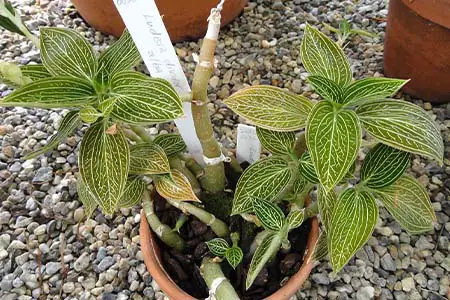
Daderot, CC0, via Wikimedia Commons
1.3 Lithophytic orchids
Lithophytes grow on the surfaces or in the crevices of rocks. They get their moisture and nutrients from rainwater and nearby dead plant matter.
About 5 percent of orchids are lithophytic, for example, species of Cattleyas, Dendrobiums, Bulbophyllum. They can also be potted up as houseplants.
Their roots also have a bigger diameter and fewer hairs than other orchids, and this is believed to be an adaptation that helps them take in what little nutrients are available on the rock’s surface.
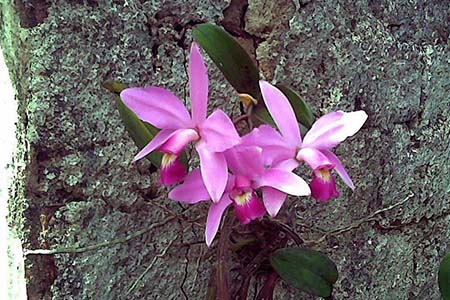
(Hellen Perrone, Public domain, via Wikimedia Commons)
1.4 Saprophytic orchids
Saprophytic orchids don’t have leaves and no chlorophyll and so cannot perform photosynthesis to produce energy. Instead, they rely on other organisms (fungus) for their energy and carbon needs. Examples include the orchid species in the genus of Cyrtosia which are mostly found in China, Japan, and Korea.
Saprophytic orchids can only be found in the wild on forest floors and cannot be cultivated as houseplants. This is because they have no leaves and chlorophyll and need to live off a fungus that lives off dead organic matter in nature.
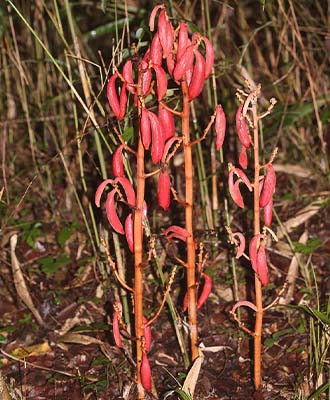
(Alpsdake, CC BY-SA 4.0, via Wikimedia Commons)
Some researchers have argued that it is not accurate to call these orchids saprophytes (plants that get nutrients and energy from decaying organic matter). Rather, they call them “myco-heterotrophic” because these orchids get their energy by parasitizing soil fungi around their roots. (US Department of Agriculture, n.d)
Virtually all orchids are myco-heterotrophic at the initial stages, as the tiny seeds don’t have enough energy to grow on their own. Consequently, they get nutrients needed for germination and seedling development from the fungi around. (Sathiyadash et al., 2020)
2. Characteristics of orchids
Epiphytic orchids have certain biological characteristics, and these have been adapted to how epiphytes grow and the environment they live in. These characteristics include their habitat, leaves, roots, stem, and the presence of a pseudobulb
2.1 Habitat
Epiphytic orchids are found mostly in the tropics and subtropics, where there’s a relatively equal amount of sun throughout the year, the temperature is stable, it is warm all year round, and there is high humidity.
Orchids can grow on any part of a tree, but they tend to grow on the inner, mature branches that provide light shade. Epiphytic orchids can live for several years; most will live more than 10 years, and with proper care can last decades.
2.2 Roots
The roots of epiphytic orchids are called aerial roots because they aren’t buried in the soil. These aerial roots have adapted to absorb water and nutrients differently than orchids with terrestrial roots.
Most epiphytic orchids have thick roots covered in a white substance called velamen radicum, a spongy material made of dead cells. The velamen helps absorb water and nutrients from the moist air, prevent water losses from transpiration, and attach the plant to the tree (Zotz and Winkler, 2013).
When raindrops or dew touch the roots, they appear green as the velamen becomes wet, revealing the photosynthetic roots underneath. They become white again when the velamen dries out.
The roots of orchids also contain mycorrhizal fungi. These fungi are essential for the germination of orchid seeds and seedlings. However in adult orchids, the fungi can provide the plant with phosphorus and nitrogen (Li et al., 2021).
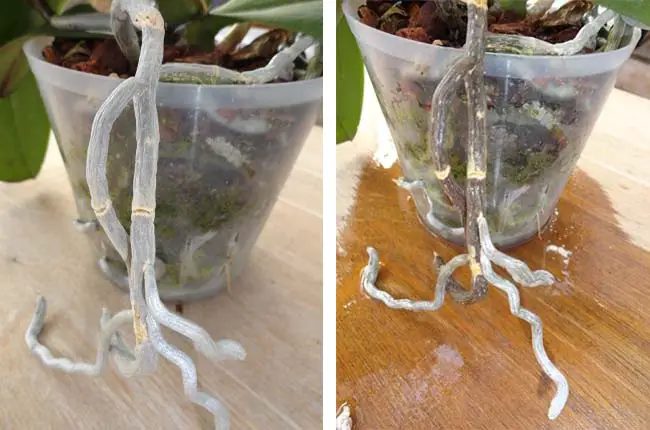
2.3 Stems
All orchids are non-woody perennial herbs. Their stem structure is either monopodial or sympodial.
Monopodial orchids have single stems that grow vertically upright. Leaves develop from the top of the stem each year, after which the stem grows longer and another leaf shoots out on the other side, in an alternating pattern. Monopodial orchids can grow to several feet (1 to 1.5 meter) in height.
Examples of monopodial orchids include Phalaenopsis and Vandas.
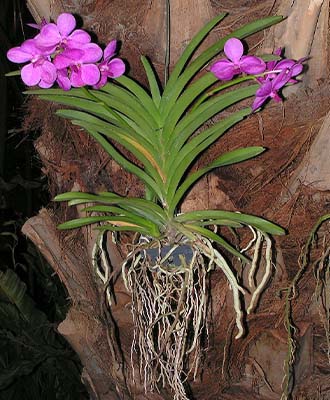
(Bff, CC BY-SA 3.0, via Wikimedia Commons)
A sympodial orchid stem grows horizontally rather than vertically. From this basal stem arises vertical thickened stems called pseudobulbs from which the leaves grow. The basal stem continues to grow horizontally producing even more pseudobulbs (Texas A&M, n.d).
Examples of symopodial orchids include Dendrobiums, Cattleyas, Cymbidums, Paphiopedilums, Oncidiums, Bulbophyllum.
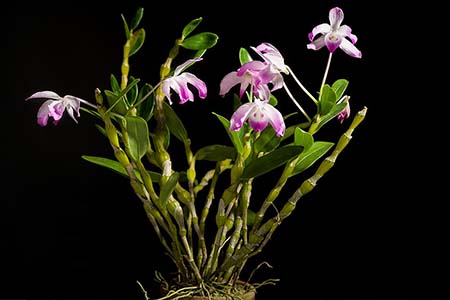
(Motohiro SUNOUCHI, CC BY 4.0, via Wikimedia Commons)
2.4 Leaves
Epiphytic orchids typically have succulent leaves with thick cell walls, and sunken stomata, and some are covered by a waxy cuticle. Like the majority of plants, the leaves are responsible for photosynthesis.
Most epiphytic orchids use the CAM (Crassulacean Acid Metabolism) photosynthetic pathway. As this is the most water-effective type of photosynthesis and is well suited to the arid microenvironments of most epiphytes in the tropics and subtropics. (Silvera et al., 2009)
In photosynthesis, plants take in CO2 by opening up their stomata which are little holes on one side of the leaves. But this also allows water to escape from the leaves by transpiration.
In the CAM photosynthetic pathway, the plant only opens its stomata at night when temperatures have cooled and the rate of evaporation and vapor pressure is greatly reduced. This allows the plant to absorb CO2 without losing much water. The plant then stores the CO2 as organic acids to be used in photosynthesis when the sun rises the next day. (Fu et al., 2022)
The tropics and subtropics aren’t arid themselves. But high up in the tree branches, epiphytes don’t have soil or any water-holding medium. They only get water when it rains or from fog, which quickly dries off. As such, while the forest floor may be moist, the epiphyte’s immediate surroundings can be dry especially in between rainfalls. Epiphytic orchids (and other plants like bromeliads and pineapples) use CAM photosynthesis to conserve scarce water resources.
2.4 Pseudobulb
Pseudobulbs are unique to sympodial orchids, such as Dendrobiums, Cattleyas, Cymbidiums. In other words, monopodial orchids, such as Phalaenopsis, don’t have pseudobulbs.
They are thickened stems that grow from the basal creeping stem or rhizome. All leaves and sometimes, flower stems grow from the pseudobulbs.
The Pseudobulbs are storage organs that contain water for use in periods of little rainfall or drought.
Pseudobulbs can offer signs about the health status of the orchid if they are wrinkled or rotten.
3. Examples of popular orchids
While there are numerous epiphytic orchids some are more well-known. He has a list of some of the most popular epiphytic orchids
3.1 Phalaenopsis
Commonly known as moth orchids, Phalaenopsis is a genus of around 70 species native to southeast Asia, and Australia.
Moth orchids are epiphytic and monopodial, with long coarse roots and short stems that bear several large leathery leaves.
A flower stalk sprouts from the base of the stem with flowers that are long-lasting (2 to 5 months) and brightly colored (pink, white, yellow, purple). Each flower consists of two lateral petals, a labellum, a column in the center that houses the reproductive parts, and three sepals that are the same color as the petals.
Phalaenopsis grow best in tropical temperatures between 70–95 °F (21–35 °C) but can also adapt to warmer temperatures between 59–86 °F (15 to 30 °C). Moth orchids prefer moderate humidity and low light.
Popular moth orchids include:
- Phalaenopsis stuartiana
- Phalaenopsis amabilis
- Phalaenopsis schilleriana
- Phalaenopsis liodoro
Miniature Phalaenopsis are popular options for office, home or indoor space as their mature size is mostly 6 to 7 inches (15 – 18 cm) tall.
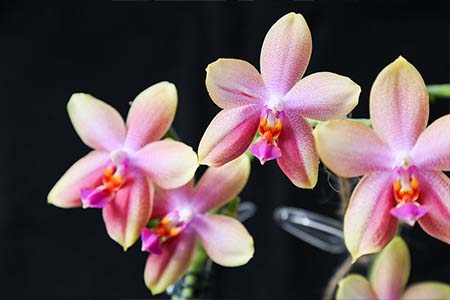
(Maja Dumat from Deutschland (Germany), CC BY 2.0, via Wikimedia Commons)
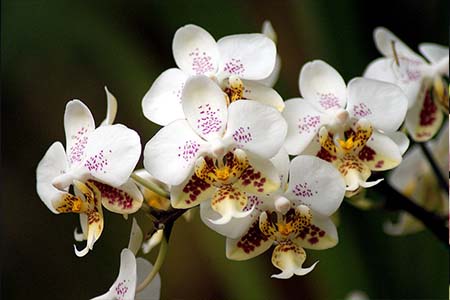
(Elena Gaillard from New York, USA / CC BY 2.0, via Wikimedia Commons)

(Photo by David J. Stang, CC BY-SA 4.0, via Wikimedia Commons)
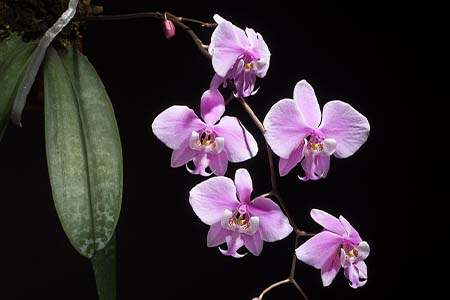
(sunoochi from Sapporo, Hokkaido, Japan, CC BY 2.0, via Wikimedia Commons)
3.2 Dendrobium
Dendrobiums are a large genus of mostly epiphytic and lithophytic orchids native to East and Southeastern Asia and the Pacific Islands.
Dendrobiums are sympodial orchids with short aerial roots covered in velamen. The pseudobulbs are frequently hard, elongated, and cane-like with leaves growing from the top.
The leaves differ between the over 1400 dendrobium species. However, they’re typically oblong, linear, or cylindrical. Some species have leaves that fall off after each season, while others last several seasons.
The flowers range from few to several arranged on the raceme. They’re typically white, green, yellow, pink, or purple with lateral sepals joined at the base forming a sac. Sepals and petals look similar to each other but are significantly different from the labellum.
The various Dendrobium species have different ideal temperatures and humidity levels. But generally, Dendrobiums prefer moderate to high humidity (50 to 70%) and temperatures above 60 °F (15.5 °C). Some popular Dendrobium species are listed below
- Dendrobium crepidatum
- Dendrobium densiflorum
- Dendrobium bigibbum (Cooktown orchid)
- Dendrobium nobile
- Dendrobium crumenatum (Pigeon orchid)
- Dendrobium aphyllum
- Dendrobium taurinum
- Dendrobium chrysotoxum
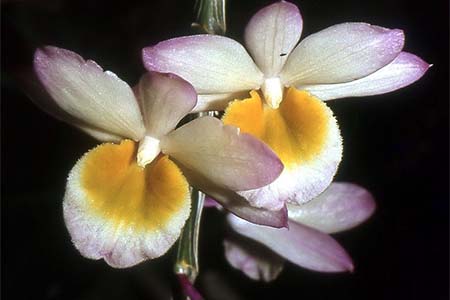
(Orchi, CC BY-SA 3.0, via Wikimedia Commons)

(www.larsen-twins.dk, via Wikimedia Commons)
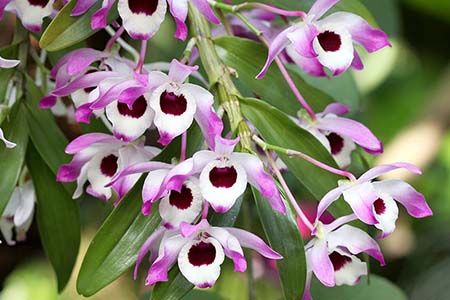
(Maja Dumat from Deutschland (Germany), CC BY 2.0, via Wikimedia Commons)
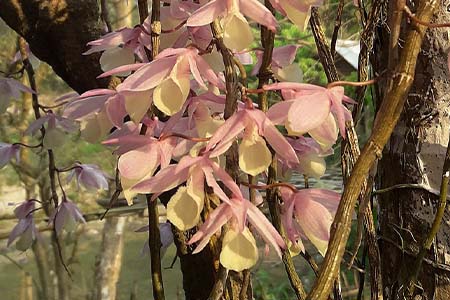
(অজয় দাস, CC BY-SA 4.0, via Wikimedia Commons)
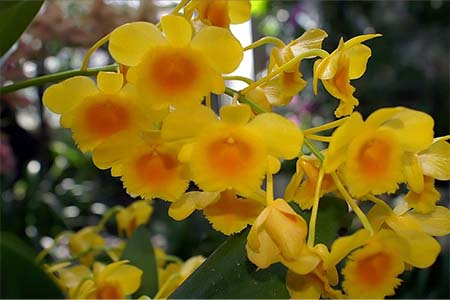
(Photo by David J. Stang, CC BY-SA 4.0, via Wikimedia Commons)
3.3 Cattleya
Also called corsage orchids, Cattleya is a small genus of sympodial orchids native to tropical South and Central America. Some of them grow on trees (epiphytic) and others on rocks (lithophytic).
They have slender roots covered in velamen. Pseudobulbs are either conical or cylindrical with single or double leaves growing from them. The leaves are of different shapes and are somewhat succulent.
Cattleyas produce a few to several yellow, white, pink, or purple fragrant flowers that have two petals that are similar to the sepals, and a distinct labellum with a column in the center housing reproductive parts. Species that produce few flowers also produce bigger flowers and vice versa.
Ideal temperatures for Cattleyas are between 65 to 85 °F (19 – 30 °C). And moderately high humidity of 50 to 70%.
Popular examples of Cattleya include;
- Cattleya warneri
- Cattleya dowiana
- Cattleya schilleriana
- Cattleya perciviliana
- Cattleya labiata
Miniature Cattleyas are especially attractive for their petite, compact plant size contrasted with huge, showy blooms.

(Dalton Holland Baptista, CC BY-SA 3.0, via Wikimedia Commons)
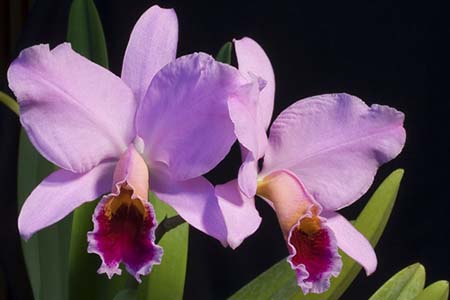
(cattleyasource (http://www.wikidot.com/user:info/cattleyasource), CC BY-SA 3.0, via Wikimedia Commons)
3.4 Cymbidium
Also known as boat orchids, Cymbidium is a genus of mostly sympodial epiphytic orchids, from tropical and subtropical Asia.
Cymbidium roots are pale, long, and of medium thickness. As sympodial orchids, they have short pseudobulbs that bear three to twelve long, thin, leathery, and blade-like leaves, which last for many years before falling off.
The inflorescence consists of several flowers arranged on a flower stalk that grows from the base of the pseudobulb. The flowers have fleshy and waxy petals and sepals of the same color and roughly the same size, and a distinctly colored labellum. Typical colors are yellow, maroon, white, brown, and pink. Some species have fragrant flowers.
Cymbidiums thrive in temperatures between 50 to 75 °F (10 to 24 °C). But they are a bit hardy, so can tolerate temperatures as low as 38 °F (3 °C). As for humidity, they prefer moderate levels between 40 to 60%.
Some examples of boat orchids include
- Cymbidium tracyanum
- Cymbidium dayanum (phoenix orchid)
- Cymbidium Crescent Tears
- Cymbidium pipets (royal gem)
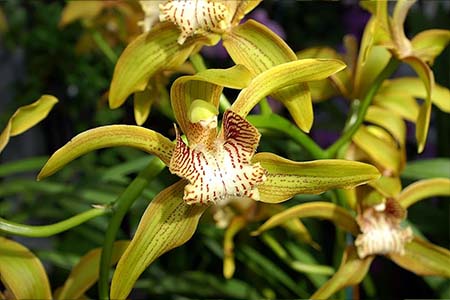
(Photo by David J. Stang, CC BY-SA 4.0, via Wikimedia Commons)
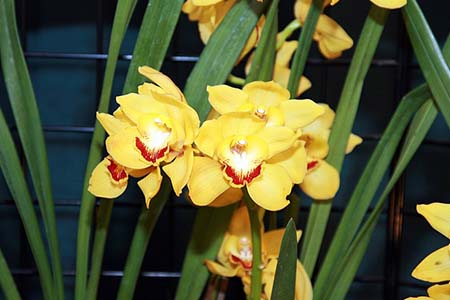
(Photo by David J. Stang, CC BY-SA 4.0, via Wikimedia Commons)
3.5 Vanda
This genus is native to India, Southeast Asia, China, the Philippines, and parts of Australia. It comprises mostly epiphytes.
Orchids in the Vanda genus are monopodial with long stems that have flat, strap-like leaves. The roots are long, moderately thick, and silvery-white.
A flower stalk grows from between the leaves and produces a few to several white, yellow, pink, brown, purple, or orange flowers.
Unlike other orchids, the flowers of Vandas don’t have a depression in the middle but are flat. The two petals and three sepals are very similar in appearance and shape, and there’s a small indistinct labellum. Flowers are often fragrant and last up to a month.
Vanda species prefer warm temperatures, between 65 to 85 °F (19 to 30 °C). Ideal humidity for Vandas is 70 to 80%. Popular species include:
- Vanda sanderiana (Waling-Waling or Sander’s Vanda)
- Vanda bensonii (Benson’s Vanda)
- Vanda coerulea (Blue Vanda)
- Vanda tricolor
- Vanda flabellate

(Badlydrawnboy22, CC BY-SA 3.0, via Wikimedia Commons)
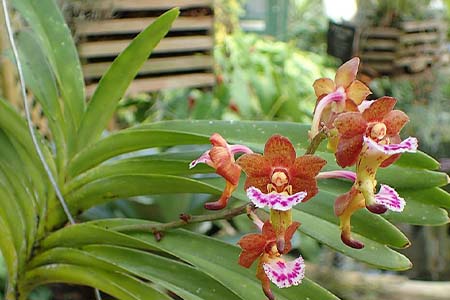
(Krzysztof Ziarnek, Kenraiz, CC BY-SA 4.0, via Wikimedia Commons)
3.6 Paphiopedilum
Paphiopedilum is commonly called slipper orchid. Species in this genus are terrestrial and sympodial but lack the pseudobulbs characteristic of other sympodial orchids. Instead of pseudobulbs, slipper orchids have thick shoots that bear many leaves.
The leaf shape differs between species– round and short with variegation or long and narrow without variegation. A flower stalk emerges from between the leaves and bears yellow, pink, white, purple, or maroon flowers
Paph flowers bloom once a year, with broad, waxy, leathery, narrow, spiral-like, or rounded petals and sepals, and a distinctive labellum that folds to form a pouch. The flowers can last up to two or three months.
A temperature range of 75 to 85 °F (24 – 30 °C) and humidity between 40 and 70% is ideal. Some examples of slipper orchids include:
- Paphiopedilum delenatii
- Paphiopedilum parishii
- Paphiopedilum lowii

(Guy Waterval, CC BY-SA 4.0, via Wikimedia Commons)
3.7 Oncidium
Another name for this genus is the dancing lady orchid, and it’s found in Central and South America.
Oncidiums are epiphytic and have a mass of thin white roots. They’re sympodial epiphytes, and as such have pseudobulbs that bear one to three strap-like and somewhat thin leaves.
Oncidiums produce racemes with several flowers, typically red, white, pink, yellow, or a mix of two of these colors. The petals and sepals look alike and have ruffled edges, the labellum is also ruffled but considerably bigger than the petals and sepals.
Oncidiums vary in size, some species, like Oncidium baueri, can grow up to five meters. Other examples of Oncidiums include.
- Oncidium sarcodes
- Oncidium pulchellum
- Oncidium leucochilum
- Oncidium sphacelatum

(Photo by David J. Stang, CC BY-SA 4.0, via Wikimedia Commons)
These plants prefer warmer temperatures. Cold drafts and long exposure to temperatures below 50 °F (10 °C) can slow down their growth. Humidity levels between 50 and 75% are sufficient.
3.8 Miltoniopsis
Miltoniopsis orchids are epiphytic, native to the rainforests of Central and South America, particularly Costa Rica, Peru, Ecuador, Venezuela, and Colombia.
They have numerous pale and fine roots. They display sympodial growth, producing several, closely packed pseudobulbs.
The bulbs are greenish grey and appear flattened or compressed, but with rounded edges. Each pseudobulb produces a thin and single grass-like leaf with a central vein that acts as a fold.
Miltoniopsis orchids are also called pansy orchids because of their bright open flowers that bloom once or twice a year. They come in a range of colors, typically red, white, yellow, pink, maroon, and purple, or a mix of two of these colors.
The flowers are big (3 to 4 inches in diameter). Sepals and petals are almost identical. But like other orchids, the labellum is significantly larger, and can sometimes have a different color pattern from the tepals. Additionally, the labellum is also bilobed and fused with the column in the center housing the flower’s reproductive parts. The blooms are fragrant and can last four to six weeks on the plant.
They prefer moderate temperatures, not too cold and not too hot: 70-80 °F (21-26 °C) by day, and they will tolerate night temperatures not lower than 50 °F (10 °C).
Humidity levels should be moderately high at about 60 to 70%.
The Miltoniopsis is a small genus of epiphytic orchids, with just five recognized species (American Orchid Society, n.d). The five recognized Miltoniopsis are:
- Miltoniopsis roezlii
- Miltoniopsis bismarckii
- Miltoniopsis phalaenopsis
- Miltoniopsis warscewiczii
- Miltoniopsis vexillaria (flag-like miltoniopsis)
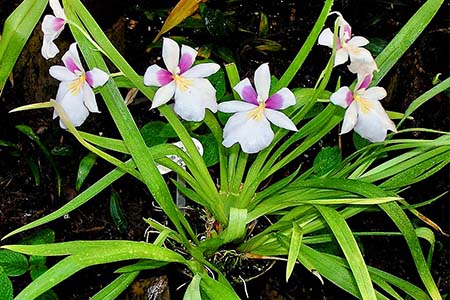
(NasserHalaweh, CC BY-SA 4.0, via Wikimedia Commons)
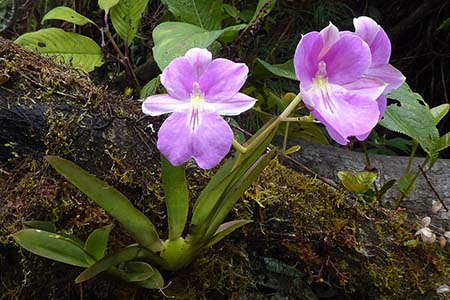
(iNaturalist user: thibaudaronson, CC BY-SA 4.0, via Wikimedia Commons)
3.9 Bulbophyllum
With over 2000 species, this is the largest genus of orchids, with mostly epiphytes and some lithophytes mixed in too (Hosseini and Dadkhah, 2016).
Species in this genus are found in warm climates throughout the world. They have a pale, fibrous, and fine root system for attaching to the tree branches.
These orchids have sympodial growth, with pseudobulbs extending from the rhizome. The bulbs usually bear a single, succulent leaf with a slight fold running down the middle.
The flowers emerge from a raceme that grows from the base of the pseudobulb. Common flower colors include maroon, orange, yellow, purple, and pink.
The flowers are usually small and consist of smaller petals that may be free or joined, a free dorsal sepal, and two bigger lateral sepals that may also be free or joined. The labellum is fleshy, curved, and fused to the column in the middle which contains the reproductive parts.
Generally, Bulbophyllum species like warm temperatures between 65 to 75 °F (19 – 24 °C).
Some species have fragrant flowers but most give off a foul smell. Some selected species include
- Bulbophyllum abbreviatum
- Bulbophyllum dearei
- Bulbophyllum echinolabium
- Bulbophyllum falcatum
- Bulbophyllum fascinator
- Bulbophyllum lasiochilum
- Bulbophyllum makoyanum
- Bulbophyllum medusae

(Phhoto via via Wikimedia Commons)
Quick Summary
| Orchid genus | Characteristics and optimal conditions |
| Phalaenopsis | Epiphytic, Monopodial Thick roots 59-95°F (15–35°C) |
| Dendrobium | Epiphytic, lithophytic Sympodial above 60°F (15.5°C) 50-70% humidity |
| Cattleya | Epiphytic, lithophytic Sympodial big flowers, some fragrant 65 to 85 °F (19 – 30 °C) 50-70% humidity |
| Cymbidium | Epiphytic Sympodial Medium-thick roots 50 to 75 °F (10 to 24 °C) can tolerate 38 °F (3 °C) 40-60% humidity |
| Vanda | Epiphytic Monopodial Thick roots 65 to 85 °F (19 to 30 °C) 70-80% humidity |
| Oncidium | Epiphytic Sympodial Above 14°F (10°C) 50-75% humidity |
| Paphiopedilum | Terrestrial, Sympodial Thick roots 75 to 85 °F (24 – 30 °C) 40-70% humidity |
| Miltoniopsis | Epiphytic Fine roots Sympodial Thin grass-like leaves Huge, fragrant, bright-colored flowers 0-80 °F (21-26 °C) 60 to 70% humidity |
| Bulbophyllum | Epiphytic, lithophytic Sympodial 65 to 75 °F (19 – 24 °C) |
Final thoughts
Orchids that are epiphytic, lithophytic, and terrestrial can perfectly be potted up and grown as houseplants. Those that are grown as houseplants are mostly epiphytic, except Paphiopedilum (slipper orchids) which is terrestrial and has to be grown in soil.
Being epiphytic, the majority of the house orchids (especially Phalaenopsis) have thick roots that can attach themselves to a surface. They can be mounted to a surface, bare-rooted without a pot and they can also be potted up in a well-ventilated medium such as moss and bark.
Orchids from the nine popular categories make perfect houseplants because they are adapted to conditions that are similar to those indoors. In terms of lighting, most of these orchids can tolerate low light indoor conditions, with some exceptions such as Vandas which can even tolerate full sun. Most of the orchids also prefer warm temperatures and do not need to be watered as often as they have succulent leaves, some even with bulbs, to help conserve water.
Many of the orchids produce huge and brightly colored flowers from pink to purple, yellow, white, and red. Some flowers are even fragrant, although a few are foul-smelling.
So, have you found your favorite orchid to grow at home? Tell us in the comments below!
Related
43 Variegated Orchids You Will Love (with Pictures)
8 Unique Miniature Cattleyas (with Large Blooms )
References
Catalogue of life. (2019). Catalogue of Life – 2019 Annual Checklist : Browse taxonomic classification.
Fay, M. F. (2018, June 5). Orchid conservation: how can we meet the challenges in the twenty-first century? – Botanical Studies. SpringerOpen.
Orchids and How They Grow. (2004, April 1). Brooklyn Botanic Garden.
Zhang, S., Yang, Y., & Li, J. (2018, August 4). Physiological diversity of orchids. ScienceDirect.
De, L. C., Singh, D. R., & Barman, D. (2016, September 1).Valuable terrestrial orchids: An overview. ResearchGate.
United States Department of Agriculture. (n.d.). What are Mycotrophic Wildflowers? USDA. https://www.fs.fed.us/wildflowers/beauty/mycotrophic/whatarethey.shtml
Sathiyadash, K., Muthukumar, T., Karthikeyan, V., & Rajendran, K. (2020). Orchid Mycorrhizal Fungi: Structure, Function, and Diversity. SpringerLink.
Zotz, G. (2013, January 6). Aerial roots of epiphytic orchids: the velamen radicum and its role in water and nutrient uptake. SpringerLink.
Li, T., Yang, W., & Wu, S. (2021). Progress and Prospects of Mycorrhizal Fungal Diversity in Orchids. Frontiers.
Fu, Z., Martin, C., Do, J., & Wagner, B. (2022, March 9). Functional relationship between leaf/stem pseudobulb size and photosynthetic pathway in the Orchidaceae. BioOne Complete.
Texas A&M University. (n.d.). Orchidaceae or Orchid Family. TAMU.
Silvera, K., Santiago, L. S., Cushman, J. C., & Winter, K. (2009, January 30). Crassulacean Acid Metabolism and Epiphytism Linked to Adaptive Radiations in the Orchidaceae. OUP Academic.
Hosseini, S. H., & Dadkhah, K. (2016, August 1). Intergeneric classification of genus Bulbophyllum from peninsular Malaysia based on combined morphological and sequence data. ResearchGate.
- Keiki Paste vs Rooting Hormone:What’s the difference? - February 4, 2024
- Top 10 Orchid Fertilizers: A Comprehensive Review (2024) - February 2, 2024
- Top 8 Soil Inoculants For Stronger Plants (2024) - February 1, 2024

